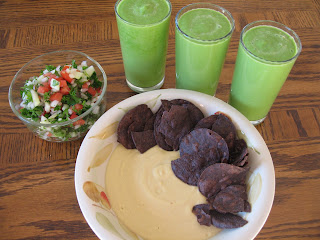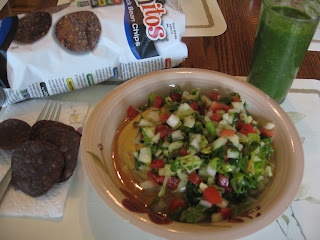This eye-opening article needs to be posted and shared with others. Meat, no matter the country, is being contaminated, sometimes willfully, sometimes neglectfully, and sometimes by ardent carelessness or governmental or economic design. I was really surprised by the comparison between Korean beef and American beef as there's been so much rap in the media since the Beef Riots in 2008 here in Seoul about American beef being contaminated, American beef taken from downer cows, American beef fed corn for fattening the cows but not flavoring them ... and Korea beef is trophied as being highly surperior, which is empirically believed in South Korea. Well, another myth has been busted, and in today's lethal drug-infested world, it's just better to be a happy vegetarian than a beefy antibiotic eater.
"Know What’s in Your Food"
By Lee Seung-hee
South
Korea is one of the most health-conscious countries in the world. A TV show
here, ``Vitamin," which aims to provide nutrition and disease related
information, has gained popularity since 2003 and influenced the general
population to be more concerned about nutrition and aware of chronic diseases
deriving from diet.
``What to eat and what not to eat" is a common
interest in everyday Korean life. Once a specific food or a nutrient gains the
reputation for being healthy, it really gains in popularity. For example, ox
tail soup is known to alleviate arthritis and beef blood soup is good for
soothing menstrual cramps.
If a specific food or nutrient gains a
negative reputation, it gets stigmatized. For example, it is known that salt is
blamed for elevated blood pressure and animal fat for developing plaque in blood
vessels.
However, do we know what's in our food besides the nutrients?
Did you know that antibiotics are fed to livestock? Korean livestock farmers
used 0.91 kilograms of antibiotics for every ton of livestock in 2002 compared
to the United States' 0.14 kilograms, according to a report from the Korean
Animal Welfare Association (KAWA). Livestock farmers in Korea spend more money
than anyone else in the world on feeding antibiotics to their pigs and
cows.
Wait. Antibiotics? Are we eating sick animals that have been
treated by antibiotics? No. It's a precautionary measure, just in case they get
sick. But if they are not sick, why are they being fed with the exact same
antibiotics that are used for clinical purposes? It's because it is almost
impossible for animals to survive in a crowded farm environment without the
antibiotics.
KAWA reported that the unsanitary, enclosed and artificial
environment requires farmers to administer various medicines. Therefore, farmers
administer antibiotics regularly even when livestock are not ill to prevent
animals from getting diseases, because if one pig gets sick it can easily spread
to others in the farm, and eventually farmers will lose money. It is much more
economical to use antibiotics than to deal with sick or dying farm animals.
Although this model is beneficial for farmers, is it beneficial for
people who are eating meat that's been tainted with antibiotics? Farmers
administer antibiotics in order to improve the immune system of the animals and
to ensure their survival, but the overuse of antibiotics leads to humans'
development of resistance to certain diseases.
One solution seems obvious
― could we just keep the animals in a clean, un-crowded environment? In 2000,
the article ``Nutrition transition of South Korea," published in the American
Journal of Clinical Nutrition by Popkin, B. et al. showed the total daily meat
consumption of Koreans has increased from 6.6grams per person in 1969 to 67g in
1995, while daily consumption of cereal and grain products has decreased from
558.8g to 308.9g during the same period. Such a demand has prompted farmers to
grow more livestock. Due to limited land for raising livestock, overcrowding
animal farms has become a common and accepted practice.
Fortunately, the
Korean FDA announced a ban on the seven most frequently-used antibiotics in
animal feed. The swift action was spurred by worrisome results in 2008 showing
that steady use of antibiotic feed can develop into antibiotic resistance. In
addition, the Ministry of Agriculture and Forestry is planning on providing
subsidies to environmentally-friendly farmers that don't use antibiotics.
Selected farmers will be given cash over a period of three to five years in
order to support their environmentally-friendly facilities.
This is a
very progressive and advanced decision made by the Korean government at a time
when the U.S. continues to struggle with its antibiotic usage in meat
production. Such change is desirable, and we do see many antibiotic free meats
in U.S. grocery stores.
Unfortunately, in 2008, major Korean grocery
stores carried some eggs and chicken that were advertised to be antibiotic free
but were found to contain the antibiotic Enrofloxacin. On top of this problem,
these ``antibiotic-free" products are sold at 1.5 times the price of regular
eggs and chicken. Such a discrepancy results in distrusting consumers, which may
damage farmers who really do practice antibiotic free farming.
Even I
was cynical about purchasing antibiotic free, organic and
environmentally-friendly produce while I was in Korea because I was so skeptical
from various news stories that showed untrustworthy, mostly corporate farmers
breaking regulations. However, when I buy organic, free range, antibiotic free
produce in America, I am confident that it is organic. This is mainly because I
know the USDA has a strict certification process and ensures quality through
vigorous follow-ups with certified farms.
Therefore, in order to set our
tables with reliable and trustworthy foods, we the consumers should be more
aware of such consequences and demand more structured and strict regulation
among certified antibiotic-free farms.
``Knowing is not enough, we must
apply. Willing is not enough, we must do," is a famous and appropriate quote by
Johann Wolfgang van Goethe. Now that we know antibiotic usage in livestock can
cause harm to humans, the government has ``applied" a ban on the use of some
antibiotics in livestock farming and is ``willing" to protect people from
potential antibiotic resistance. It is our turn to take another step to ensure
these antibiotic-free farms and products meet regulations. Purchase meat from
local antibiotic free farms near you, support trustworthy farmers and increase
the demand of such products. Don't eat with fear but eat with philosophy ― just
know what you're eating and what's in your food.
The writer is a
nutritionist and a second-year doctoral student at Johns Hopkins Bloomberg
School of Public Health studying Human Nutrition. Her research interest focuses
on promoting healthy eating among the low-income urban population in U.S. She
can be reached at seulee@jhsph.edu.

























